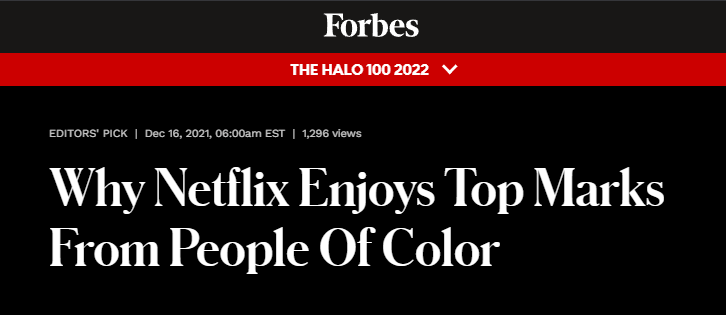HundredX Data Powers Forbes Halo 100 List

This article appeared in Forbes Online as part of the Halo 100 List of Companies and Brands that Consumers Love. The Forbes Halo 100 list is powered by HundredX.
Netflix for years has prided itself on running content that appeals to diverse communities, including Black and Brown audiences.
And that philosophy may have helped place the video-streaming company near the front of the pack for customer satisfaction among people of color in the Forbes Halo 100, powered by HundredX. Netflix ranked No. 66 out of more than 2,000 brands but, among non-white respondents, the video-streaming service came in at No. 15.
Andre Benjamin, vice-president of strategy at HundredX, notes that the diversity of content on Netflix played a key role in giving it high marks among customers of color.
"We saw examples of Asian people saying that they liked the fact that anime and Korean dramas were highlighted and some Black people highlighted Black comedies, Black movies," Benjamin said.
Los Gatos, Calif.-based Netflix is among the largest video-streaming companies, with about 214 million global subscribers. While the company doesn’t break out its U.S. subscriber base, research firm Kantar says it’s in about 55% of U.S. households, the highest penetration rate among video-streaming providers.
To fend off rivals and better control its fate, Netflix has been investing more in original content—as opposed to licensed content—amid a wave of content licensors starting their own streaming services in recent years. Disney+ and HBO Max are a few such rivals.
By 2025 roughly 47% of Netflix’s content budget is projected to be for originals, according to S&P Global Market Intelligence’s Kagan media research division, compared to about 38% in 2020.
Read The Full Story at Forbes Online, Click Here
For a sample of streaming services insights from the HundredX Solution, Click Here
Learn more about HundredX and our solutions by requesting a demo.
Strategy Made Smarter
HundredX works with a variety of companies and their investors to answer some of the most important strategy questions in business:
- Where are customers "migrating"?
- What are they saying they will use more of in the next 12 months?
- What are the key drivers of their purchase decisions and financial outcomes?
Current clients see immediate benefits across multiple areas including strategy, finance, operations, pricing, investing, and marketing.
Our insights enable business leaders to define and identify specific drivers and decisions enabling them to grow their market share.
Please contact our team to learn more about which businesses across 75 industries are best positioned with customers and the decisions you can make to grow your brand’s market share.



